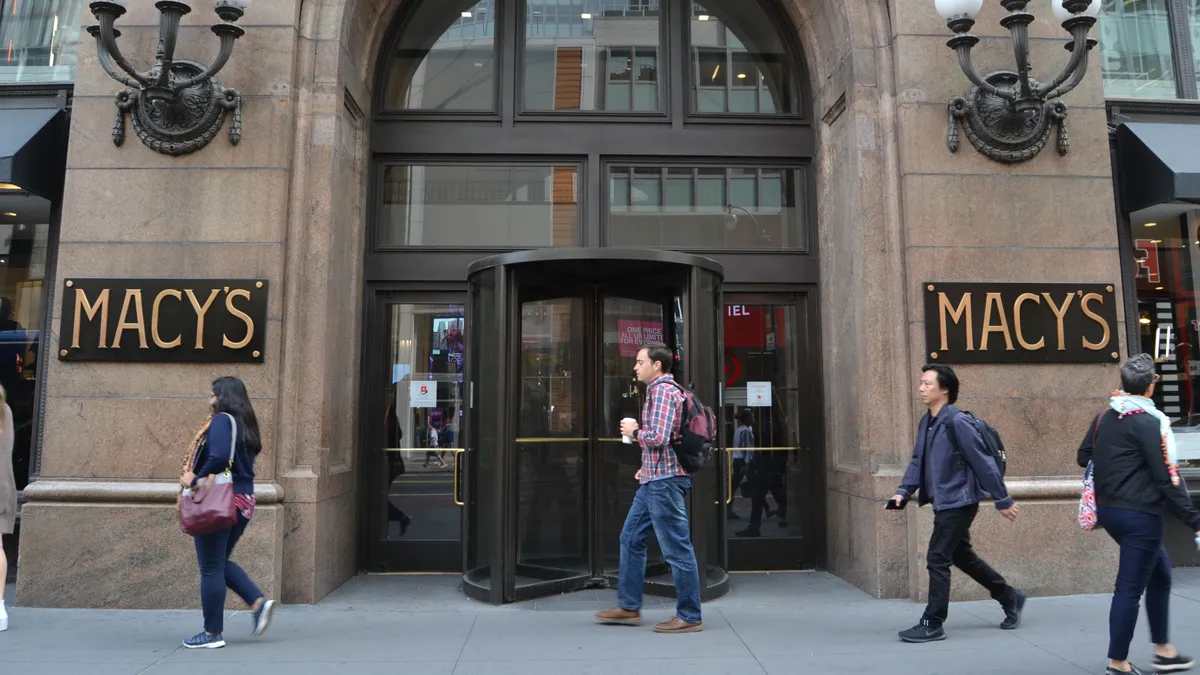Department stores have once again decked the halls this holiday season to lure shoppers into their stores. But as the twinkling lights dim, what's left behind are the same old disappointing results.
But it shouldn't come as a surprise that department stores lag.
The reason is simple: department stores continue to lose market share. The original full-line department stores (think of Sears or Montgomery Ward) carried everything a household needed — clothes, appliances, linens, etc. But eventually, those departments became individual stores — Best Buy took over the electronics department, Marshall's took over the apparel department, HomeGoods took over the furniture department, and so on. People flocked to these individual stores over the department store, and for good reason, according to Nick Egelanian, president of retail development consultants SiteWorks.
"If you're making it easier and cheaper to buy that stuff outside of the department store, people are going to leave the department stores and go to the other places, and that's exactly what happened," he said in an interview with Retail Dive.
And the fashion department stores that remain — Macy's, Hudson's Bay (parent company to Saks and Lord & Taylor) and others — appear to face the same fate.
3 quarters of positive comp sales isn't enough
The first three quarters of fiscal year 2018 saw positive comp sales growth from players like Kohl's, Macy's and Nordstrom, while also seeing significant losses, most notably from J.C. Penney.
However, it's important to remember that the National Retail Federation raised its 2018 retail sales forecast to be up 4.5% compared with last year. The majority of these department stores report comp sales growth less than that percentage, which means they are gaining little to no market share.
"If you see any of these guys have 5% or above comps, that's a huge victory," Egelanian said. "If you see any of them having below 3% comps, they're losing. If you see negative comps, they're dying. Anybody who gets above 5% has hit a homerun."
Compare any of these department stores to the likes of Walmart, Target or even the TJX companies, and the difference in positive comp sales growth is apparent.
"If I were them, I wouldn't be bragging for one second," Lee Peterson, EVP of brand strategy and design at WD Partners, told Retail Dive in an interview. "Like a sports team that just did OK, I wouldn't say, 'Hey, we're going to win the Super Bowl.'"
It's not all bad news
However, of the retailers in the department store category, there are some players that clearly lead the way. Kohl's and Macy's in particular have implemented tactics that have helped them perform better in recent quarters, according to analysts.
"Kohl's has shown some considerable progress in terms of what they've done in terms of their format, what they've done in terms of their loyalty program, overall in their usage of data, their inventory management," Christina Boni, VP senior credit officer at Moody's, said. "I think they've lead the pack in terms of inventory reduction. They've done a lot of the things that many of the companies continue to strive to do a better job at."
Macy's has also had a year full of changes. At the beginning of 2018, CEO Jeff Gennette announced a big investment initiative Growth50, a plan he hoped would drive faster sales growth. The plan included expansions of off-price unit Backstage, improved fixtures and updated technology, and a greater focus on leased business like food and beverage. The store saw improved growth in the third quarter in 2018 after the renovations were completed in those stores. The year also brought new partnerships and investments for Macy's. The Market @ Macy's and b8ta came into being this past year, as well as the retailer's acquisition of store concept Story.
And although Sak's Brookfield Place women's store concept in NYC proved to be ultimately unsuccessful, challenging traditional tactics and experimenting has proved to be beneficial for both Kohl's and Macy's.
"There's been a significant amount of investment made by many of the bigger players and I think the goal will be to continue to figure out how to leverage those investments, how to become more efficient," Boni said. "With department stores, there's a lot of trial. The worst thing you can do is stay still."
Expectations for the quarter and year ahead
With the strong holiday results projected this year, analysts say Q4 should bring positive results to department stores.
"It should be a relatively strong season in the sense that the calendar is quite favorable — more days between Thanksgiving and Christmas," Boni said. "Seasonal weather is also cooperating, as cold weather broke early, which helps in terms of outerwear sales. The companies have worked all year to position themselves for Q4 and it seems as such they have a good environment to be competing in."
However, as the last of the garland is taken down and the holiday sales boom dissipates, retailers will likely revert back to their less-than-impressive sales numbers in Q2 and Q3 of 2019, according to Peterson.
"When you see people like investors jump on it, it's because they're going to ride this holiday ... and then sell their stock off probably in January or February," he said.
So what does this mean for department stores for the years to come? Even more store closures and fewer malls across the country, according to Egelanian.
"What you're seeing is a collapse of an industry in slow motion, and if you think of it as a football game, it's in the fourth quarter now," he said.




















